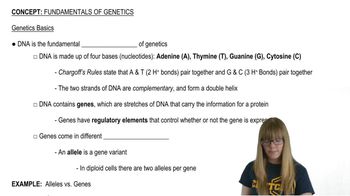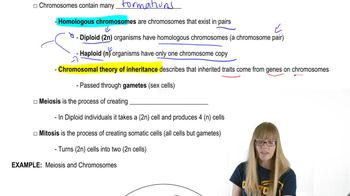Table of contents
- 1. Introduction to Genetics51m
- 2. Mendel's Laws of Inheritance3h 37m
- 3. Extensions to Mendelian Inheritance2h 41m
- 4. Genetic Mapping and Linkage2h 28m
- 5. Genetics of Bacteria and Viruses1h 21m
- 6. Chromosomal Variation1h 48m
- 7. DNA and Chromosome Structure56m
- 8. DNA Replication1h 10m
- 9. Mitosis and Meiosis1h 34m
- 10. Transcription1h 0m
- 11. Translation58m
- 12. Gene Regulation in Prokaryotes1h 19m
- 13. Gene Regulation in Eukaryotes44m
- 14. Genetic Control of Development44m
- 15. Genomes and Genomics1h 50m
- 16. Transposable Elements47m
- 17. Mutation, Repair, and Recombination1h 6m
- 18. Molecular Genetic Tools19m
- 19. Cancer Genetics29m
- 20. Quantitative Genetics1h 26m
- 21. Population Genetics50m
- 22. Evolutionary Genetics29m
1. Introduction to Genetics
Fundamentals of Genetics
Problem 24a
Textbook Question
Suppose a genotype for a protein-producing gene can have any combination of three alleles, A₁, A₂, and A₃.
Each allele produces a protein with a distinct electrophoretic mobility. Allele A₁ has the highest electrophoretic mobility, A₃ has the lowest electrophoretic mobility, and the electrophoretic mobility of A₂ is intermediate between them. Draw the appearance of gel electrophoresis protein bands for each of the possible genotypes. Be sure to label each lane of the gel with the corresponding genotype.
 Verified step by step guidance
Verified step by step guidance1
span>Identify all possible genotypes using the alleles A₁, A₂, and A₃. Since there are three alleles, the possible genotypes are: A₁A₁, A₁A₂, A₁A₃, A₂A₂, A₂A₃, and A₃A₃.</span
span>Understand the electrophoretic mobility of each allele: A₁ has the highest mobility, A₂ has intermediate mobility, and A₃ has the lowest mobility. This means that proteins produced by these alleles will migrate differently on a gel.</span
span>For each genotype, determine the number of bands and their relative positions on the gel. Homozygous genotypes (A₁A₁, A₂A₂, A₃A₃) will show a single band corresponding to the mobility of the allele. Heterozygous genotypes (A₁A₂, A₁A₃, A₂A₃) will show two bands, each corresponding to the mobility of one of the alleles.</span
span>Draw the gel electrophoresis: Create a diagram with lanes for each genotype. Label each lane with the genotype and draw bands at positions corresponding to the electrophoretic mobility of the alleles. For example, A₁A₁ will have a single band at the highest position, A₃A₃ will have a single band at the lowest position, and A₁A₂ will have two bands, one at the highest and one at the intermediate position.</span
span>Ensure that the gel diagram is clear and accurately represents the relative positions of the bands for each genotype. This visual representation will help in understanding how different genotypes can be distinguished based on their electrophoretic profiles.</span
Recommended similar problem, with video answer:
 Verified Solution
Verified SolutionThis video solution was recommended by our tutors as helpful for the problem above
Video duration:
2mPlay a video:
Was this helpful?
Key Concepts
Here are the essential concepts you must grasp in order to answer the question correctly.
Alleles and Genotypes
Alleles are different versions of a gene that can produce variations in traits. In this scenario, the alleles A₁, A₂, and A₃ represent different forms of a protein-producing gene. A genotype refers to the specific combination of alleles an individual possesses, which can influence the phenotype, or observable traits, such as protein production.
Recommended video:
Guided course

New Alleles and Migration
Electrophoretic Mobility
Electrophoretic mobility is a measure of how quickly a protein moves through a gel when an electric current is applied. This movement is influenced by the protein's size and charge. In this case, the alleles produce proteins with distinct mobilities: A₁ moves fastest, A₂ has intermediate mobility, and A₃ moves slowest, which will be reflected in the gel electrophoresis results.
Recommended video:
Guided course

Proteomics
Gel Electrophoresis
Gel electrophoresis is a laboratory technique used to separate proteins based on their size and charge. In this process, a gel matrix is used to create a medium through which proteins migrate when an electric field is applied. The resulting bands on the gel correspond to different genotypes, allowing for visual identification of the alleles present in each sample based on their electrophoretic mobility.
Recommended video:
Guided course

Proteomics

 8:55m
8:55mWatch next
Master Genetics Basics with a bite sized video explanation from Kylia Goodner
Start learning



